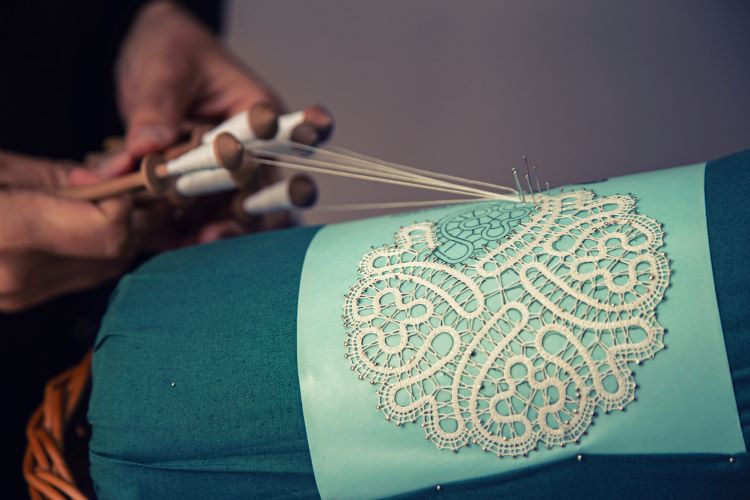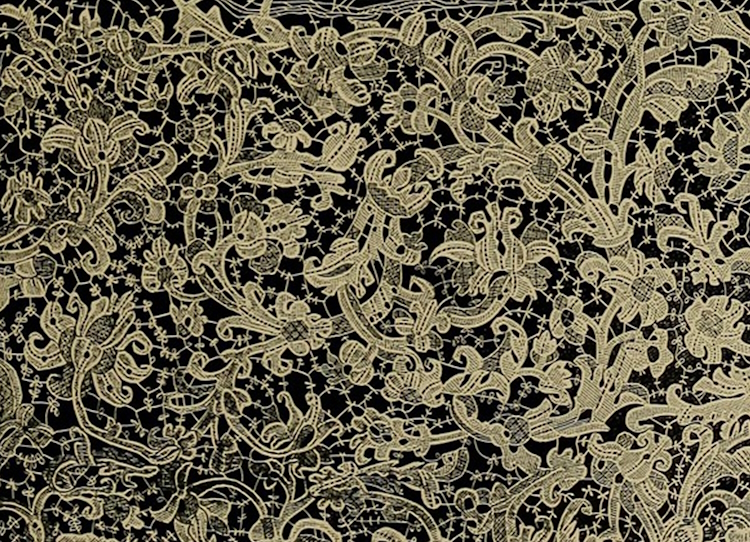The origins of lace fabrics are still unclear. While some historians claim that the art of making lace started in Greece in the late 1490s, there is a counterclaim that it began in the late 1800s by the Flemish. Despite these claims, the production of the material received great popularity in Renaissance Italy, in the city of Venice.

Lace threads were typically derived from flax fibres and later silk and metallic gold threads. By the 19th century, cotton threads were used to produce lace. Its genre is mainly classified by the production process employed and often named after the region (or town) where it is made. The well-known lace-producing centres were established in France, Italy, and Flanders (the northern part of Belgium).
Traditional Handmade Lace
Before the advent of power looms in the late 18th century, lace was exclusively woven by hand in an open-work weave, created with a pin, bobbin, or needle. The weavers used the knitting, sewing, crocheting, and knotting (tatting) systems to make the weave.
Pre-16th century, open-work embroidery art was the favourite decoration that developed into lacemaking. In the Renaissance Era, during the reign of Richard III (of England), a book of embroidery patterns and lacework appeared on the market. The word “lace” was first used to describe the royal wardrobe in the book. Some of the popularly produced traditional lace materials at the time were:
Filet lace – A type of lace that is embroidered on a net fabric.
Reticella lace – Lace made with the “drawn and cut” textile construction process.
Duchess lace – Traditional bobbin lace fabrics produced in Belgium around the mid-19th century. It was generally regarded as a cheaper version of Brussels lace.
Chantilly lace – A top-quality handmade bobbin silk lace named after the city of Chantilly in France, where it originated from. This lace production dates back to the 17th century. It is known for its fine ground, heavy detail, and distinctly outlined patterns.
Irish lace – This material, principally of the crochet genre, consists of a few variations like Limerick lace (embroidered on netting) and Carrickmacross lace, a form of sandwich lace that may be described as decorated net.
Nottingham lace – The name is a broad term used for machine-produced lace. It is an inexpensive lace and is commonly used for one-piece curtains.
Brussels lace – This fabric type covers various bobbin lace fabrics. It is a form of pillow lace that originated in Brussels.
Contemporary Lace Materials
Modern lace came about as a result of American inventiveness and is based on a simple construction process. They are more intricate, look magnificent, and have been developed to a high degree of perfection by its pioneer, Grace B. McCormick.
Types of contemporary machine-produced lace range from dainty needlepoint lace to very elaborate types like the Royal Battenburg, befitting only for royals. Today, the majority of fine lace materials come from England and France. Types of contemporary lace include:
- Guipure lace
- Baby lace
- Voile lace
- Organza lace
- Swiss lace
The beauty of contemporary lace is beyond question. With textures and designs varying from ‘extreme’ exquisite delicacy, to an extravagant opposite, they are all produced with countless braid arrangements in different patterns and forms, all connected by a great number and kinds of stitches.
